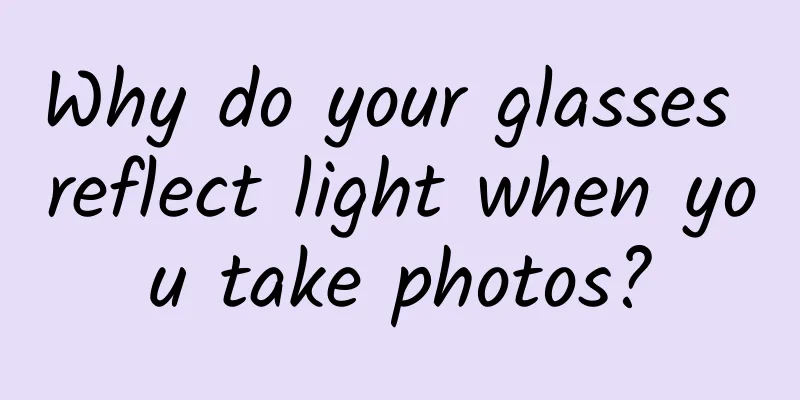Why do your glasses reflect light when you take photos?

|
Produced by: Science Popularization China Produced by: XY (Dalian Institute of Chemical Physics, Chinese Academy of Sciences) Producer: Computer Network Information Center, Chinese Academy of Sciences As the saying goes, "eyes are windows to the soul." Through them, we appreciate the changing seasons, read the vast sea of books, and put the whole world into our minds and hearts. However, excessive use will eventually overwhelm it and it will gradually become blurry, and ultimately it will take glasses to make it clear and bright again. Image source: Veer Gallery The myopia incidence rate among Chinese teenagers is as high as 50%-60%, ranking first in the world, and the total number of people wearing glasses is about 800 million! Whether it is myopic glasses that allow students to see the blackboard clearly, or reading glasses that help old men read newspapers, they all have one thing in common: they reflect specific colors under fluorescent lights or sunlight, such as emerald green: Fluorescent light reflected from glasses (Photo credit: taken by the author) Or the same blue as the sky: Fluorescent light reflected from glasses (Photo credit: taken by the author) How are these colors produced? Why do different glasses reflect different colors? Next, we will use the knowledge of optics to answer this question. Why are glasses colored? First of all, let's talk about the material of the lens. Compared with glass lenses, resin lenses are increasingly being chosen by people because of their light weight and unbreakable characteristics. The biggest disadvantage of resin lenses is that their light transmittance is significantly lower than that of glass lenses, which significantly reduces the intensity of light entering the human eye through the lenses, while the intensity of light reflected back increases, so that the objects we see will be darker than they actually appear. When others look at us wearing glasses, they will see the strong reflected light on the lenses, as if a light curtain is covering them. They cannot see the bright eyes hidden behind the glasses at all, and they also cannot capture the eyes clearly when taking pictures. Image source: Veer Gallery In order to solve this problem, people apply coating technology to lenses to reduce the reflection of light. In this way, the light passing through the lens will be significantly enhanced, achieving the purpose of beautifying oneself and brightening the eyes of others. The working principle of the anti-reflection film (or anti-reflection film) is shown in the figure. In simple terms, it is to use the reflected light formed by the incident light on both sides of the anti-reflection film to interfere with each other to form interference, so as to reduce the intensity of the reflected light to the minimum and increase the intensity of the incident light to the maximum. Working principle diagram of anti-reflection film (Image source: produced by the author) The thickness of the anti-reflection film is directly related to the wavelength (or color) of the light to be enhanced. The thickness of the anti-reflection film will be different for different colors of light to be enhanced. Therefore, a single anti-reflection film cannot achieve the same amount of enhancement of light of all colors. In this way, under the irradiation of sunlight or fluorescent lamps, which are white light formed by seven colors of light: red, orange, yellow, green, blue, indigo and purple, some light will be reflected because there is no transmittance enhancement or the transmittance enhancement is insufficient. This explains why different lenses reflect different colors. Relationship between spectral color and wavelength (Image source: created by the author) Common film colors include green film, blue film, purple-red film, gold film, etc. 1. Green film Green film is currently the most standard anti-reflection film, and it is also the most intuitive film color used to distinguish coated lenses from uncoated lenses. The green film has a poor transmittance enhancement effect at the wavelength of green light (515nm), so this green color remains in the reflected light. Relatively speaking, the green film layer is better in relieving eye fatigue, and the light green color is not easy to be found on the lens. It is the most common lens coating color. 2. Blue film Through long-term research, people have found that ultraviolet light is highly destructive to eye cells, and short-wave visible light, namely purple light and blue light, may also have a considerable degree of destructive effect on the retina. Especially for patients with age-related macular degeneration, both purple light and blue light may further accelerate the deterioration of the disease. Utilizing the characteristic of blue film lenses that reflect blue and purple light, it can reflect more than 99% of blue and purple light and radiation, creating the safest eye environment for wearers. However, the blue film also has some shortcomings: the blue light energy is reflected too much, about 10-15%. From an optical point of view, such lenses block blue light while also reducing light transmittance. 3. Purple membrane The purple-red film has a poor transmittance-enhancing effect at the wavelength of red light corresponding to 700-780nm, so the red light in this band remains in the reflected light. Its transmittance is slightly better than that of the blue-film lens because red light is not a color that the human eye is sensitive to. 4. Gold film The gold film has a poor transmittance-enhancing effect in the wavelength range of red and yellow light, so this yellow light with a strong decorative effect like gold remains in the reflected light. Selection and maintenance of glasses There is no consensus on which color of lens works best. Generally speaking, you can choose lenses with different anti-reflection coatings according to your preferences and needs, and the lighter the color of the light reflected by the lens, the better. Many people who wear glasses tend to wipe the lenses directly with clothes or paper when cleaning their glasses, which poses a risk of damaging the film layer. Because the dust, sweat and other dirt on the lens surface will be adsorbed on the lens to form very hard block-like particles after drying. If you wipe the mirror surface directly at this time, these particles will be wrapped in clothes or paper and rub the lens back and forth, which can easily scratch the anti-reflection film. The correct approach should be to first rinse and moisten the lenses with clean water, then apply detergent, hand soap or other degreasing surfactants on the lens surface, and then use a glasses cloth to absorb the water. References: [1]Qiao Qingjun. A brief analysis of the optical effects of resin lens coating[J]. 2021(2016-25):75-75. [2] Wang Xiaodong. Improvement of lens glare by multi-layer anti-reflection film. Nanjing University of Science and Technology, 2007. [3] Hao Zhihong. A brief analysis of anti-reflection coating on eyeglass lenses[J]. China Eyewear Science and Technology Magazine, 2020, No.325(03):108-111. [4] Gao Yaping. Glasses Material Technology[M]. Higher Education Press, 2015. [5] Chen Xiong. Surface treatment of resin lenses (Part 2)[J]. China Optical Science and Technology Magazine, 2000(6):2. |
>>: The most romantic thing I can think of is traveling around the world with you to see trees!
Recommend
They actually live on the seabed where there is no sunlight!
The mid-ocean ridge is 2000~3000m below the sea s...
Do we rely on Haloxylon ammodendron to find water, fix sand and strengthen virility?
Because of the Ant Forest, Haloxylon ammodendron ...
How much does it cost to invest in Zigong tableware mini program?
How much does it cost to attract investment for t...
Community shipments 5000+? 3 practical experiences to easily start community group buying
Nowadays, community group buying is booming and f...
The most complete analysis of OCPC bidding promotion!
What is OCPC, how does it work, and what accounts...
Learn the 4 ways to play Douyin live streaming!
During this period, I often saw people sharing ca...
Zengcheng SEO training: What knowledge points should be paid attention to when doing a good job in SEO ranking
1. Reasonable distribution of keyword density on ...
Once in a thousand years! The brightest gamma-ray burst to date, how did the "Insight" and "Jimu" jointly capture it?
At 2 a.m. on March 29, scientists from China, the...
Is standing at work healthier than sitting? This result is really unexpected...
Compiled by: Gong Zixin In recent years With the ...
Why hasn't BAT taken over the big fat piece of community O2O? There are too many hidden rules!
[[157017]] The community O2O market has been very...
Guide to editing information flow ads!
This article will share some key points and techn...
WeChat group novel project monthly income 10,000-30,000 practical operation method 2.0
Tutorial Contents: Section 1: Advantages of WeCha...
How to promote Xiaohongshu
With the continuous development of the Internet, ...
Three major differences between mobile and web conversion rates
For marketers, there are big differences between m...
A brief introduction to MVP's practical exercises to make the code structure simpler~
Preface To be honest, I haven't updated my bl...









